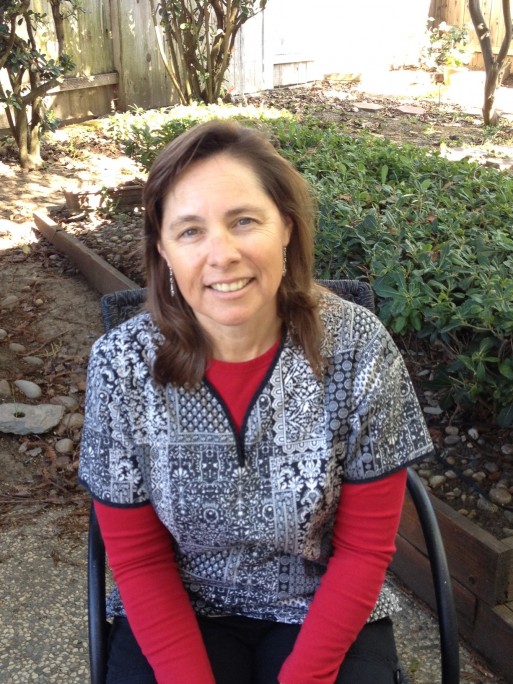Marilyn Reiss-Carradero, RN, BSN, CCRN, works at Santa Clara County Valley Medical Center in San Jose, CA, and advocates for change in palliative care and end-of-life practice. Here, she reflects on the day-to-day experiences in the hospital, the lack of preparedness in most patients for end-of-life, and the ways the system– and society– can be changed for the better.
 Liz: First, can you tell us a bit about what you do?
Liz: First, can you tell us a bit about what you do?
Marilyn: I have several different hats—at the moment, my role is Resource Nurse. There’s two of us in the hospital. We respond to rapid response calls, which is when the nurse at the bedside feels like their patient is getting sicker than she can handle and she needs help quickly. Or a code blue, when somebody has stopped breathing and their heart is stopped, we have a whole team that rushes to the scene. We handle emergencies throughout the whole hospital. Very often, there are situations where someone is in the process of dying, but decisions have not been made yet regarding how much treatment that patient is going to get: is it time to let the patient die? Has the family made that decision? Or are we going to aggressively treat the patient and escalate care to ICU? I’ve been in this role about two years, and prior to that I was in ICU—I worked for about 15 years in surgical and trauma ICU.
I’m also on the palliative care committee at our hospital. This committee meets once a month. I don’t have an official role, other than being a member, but over the last couple years I’ve chosen to educate myself in several different ways so I can get better at end-of-life care. Once I started to educate myself, I realized there’s a whole lot of things we should be doing to help our patients with a dignified end.
“The family feels this life still needs to be saved, and is holding on for a cure, or for the patient to be around another few days or weeks or months, and is in denial that this patient is dying. We’re no longer prolonging life; we’re prolonging death.”
Liz: What changes would you like to see in the community regarding palliative care and end-of-life education?
Marilyn: I don’t very commonly see a patient coming in with an advance directive, who really knows that they don’t want aggressive care. I rarely see that. What I usually see is a patient that’s never thought about it, hasn’t talked to family about it, and is now incapacitated and cannot make decisions themselves. And the family feels this life still needs to be saved, and is holding on for a cure, or for the patient to be around another few days or weeks or months, and is in denial that this patient is dying. We’re no longer prolonging life; we’re prolonging death.
We’re dealing with families that don’t want to let patients die. Period. And we’re having to convince them that it’s time. That scenario plays out every single day in my hospital.
In terms of changes I’d like to see, one would be education out in the community, especially in immigrant, non-English-speaking populations. They need to have discussions about the type of death that they would want. Most people do not want to die connected to a machine in a hospital, but that’s where they eventually end up. But we could have an educational campaign, advance directives out in the community. It is out there in some very educated, affluent populations, but not for the majority.
 Liz: What about changes within the hospital?
Liz: What about changes within the hospital?
Marilyn: Nurses and physicians need to be much more realistic about outcomes. There are certain types of patients that we know right away—elderly nursing home populations for one—may get very sick with pneumonia and end up on a ventilator. Right off the bat, there should be a discussion with the family, and they should be very frank that this patient is dying. This could even be in the ER, before they put a ventilator on the patient.
A lot of times physicians and nurses don’t use that word. But you can come into an emergency situation and right off the bat, tell the family, your loved one is dying. Tell them we’re at a point where, if they want to go naturally, if you want to allow them a natural death, we will certainly respect that and make him or her comfortable.
But what ends up happening is a physician or nurse will say, they are very, very sick, and this is what you can do to save their life: do you want it or do you not? And it’s very different, saying it like that. Do you want us to put a tube down her throat and save her life? And of course the family says yes. It might be that the patient has pneumonia and she has two days to live; if we put her on a ventilator, we may save her life and she may have a couple weeks and will go back to the nursing home. But it’s not explained that she will end up dying within the next two months anyway. They leave much sicker than they were before.
Even when we do think we can save the patient’s life, it’s still not portrayed in a very realistic light. We still don’t use that “death” word. So what I would like to see changed is a much more realistic prognosis, sitting down with the family, and explaining what allowing a natural death means. Or explaining what CPR really does to a patient, explaining how much suffering somebody might go through being put on a ventilator in ICU. We don’t do a lot of that explaining before actually doing the CPR or using the ventilator. And when the family agrees to these actions, they don’t necessarily understand that if it came to that point, the patient’s probably not going to make it out of the hospital anyway.
Liz: And what changes would you like to see on a national scale, within the health care system as a whole?
Marilyn: There was legislation in the health care package after Obama came into the presidency that would have insurance pay for that conversation. You could make an appointment with your doctor to have a conversation about your health, your wishes for end-of-life, and it could be documented in advance directives. But what ended up happening was politicians labeled it as a “death panel” and decided it shouldn’t be included in the legislation. And that’s really too bad. I’m hoping politics will not play as much of a role the next time such legislation comes up.
Next week we’ll publish the second part of our interview with Marilyn, in which we discuss the ways patients and their families can experience natural death rather than aggressive treatment, and also what you and your family can do to plan ahead.

 An Interview with Marilyn Reiss-Carradero, Pt. 1
An Interview with Marilyn Reiss-Carradero, Pt. 1


 Our Annual Seven Holiday Gifts for Someone Who Is Grieving, 2024 Edition
Our Annual Seven Holiday Gifts for Someone Who Is Grieving, 2024 Edition
 “Making Mobiles” by Karolina Merska
“Making Mobiles” by Karolina Merska
 “Hands Up to the Sky” by Michael Franti & Spearhead
“Hands Up to the Sky” by Michael Franti & Spearhead















Marilyn what a great interview – so informative. Amazing to hear an RN’s view point from inside a hospital. Your comment about prolonging death is such an obvious view point and yet we never look at it that way. Thanks so much and I can’t wait to read part 2.
Report this comment
My father had been ill for awhile and never let on as he was ready to leave this world. When he could not hide his pain from cancer any further he was immediately emitted to the hospital. The doctors always poised the next step forward to skew decisions in favor of keeping him alive. Both my mother and brother always followed where the doctor lead them. I could not get either of them to listen to me as to how the brighter picture of keeping him alive was always the slimmer and unlikely possibility. In the end my father suffered more than he should have and I felt helpless watching it happen. It was the most frustrating experience and I was deeply shocked by how the doctors always pitched the low %’s of his survival as the route to go.
Report this comment